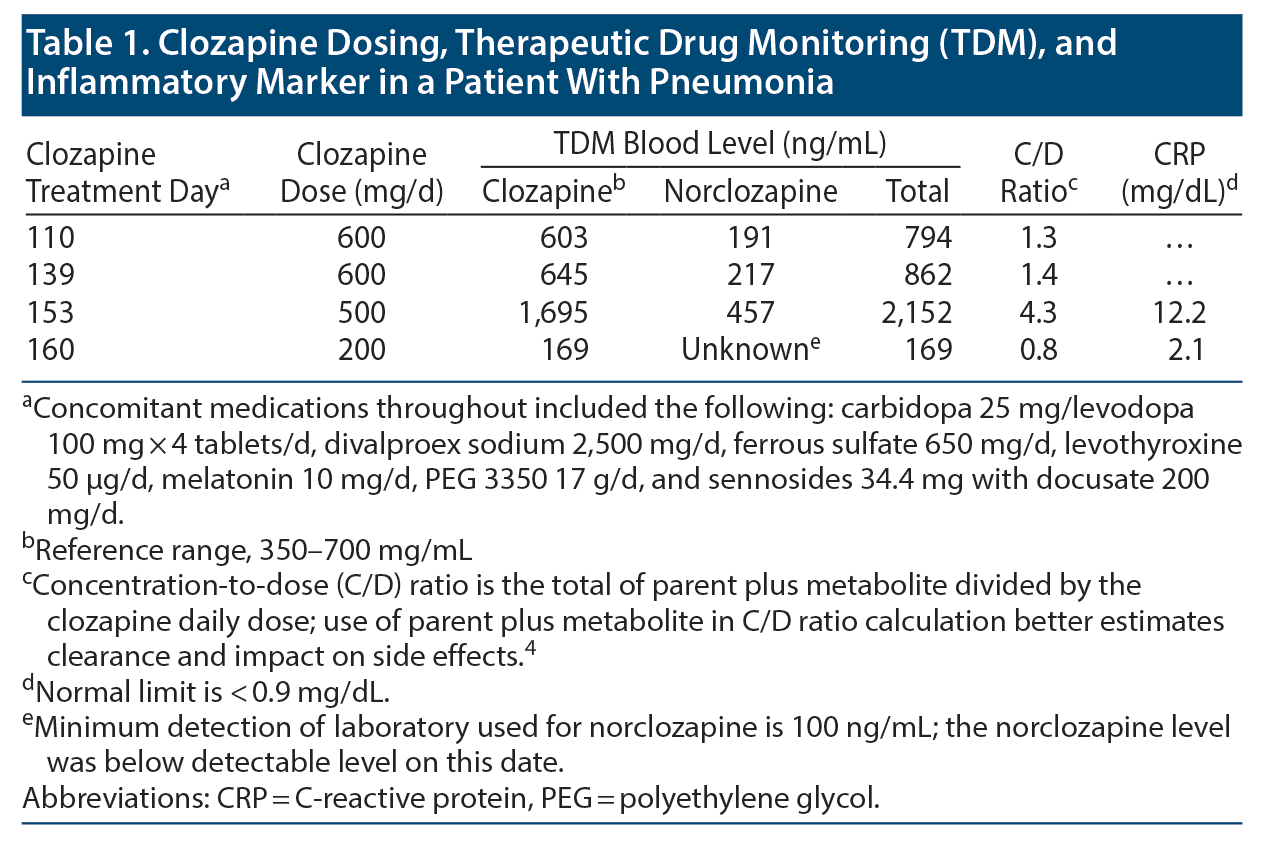
Proactive Modification to Clozapine Dose in a Patient With Pneumonia to Prevent Toxicity
Fast action is required to protect clozapine patients who have pneumonia. Patients treated with clozapine may have a higher likelihood of developing pneumonia than patients treated with other antipsychotics or the general public.1 This risk very likely comes from common clozapine side effects like sedation, dysphagia, and hypersalivation and is elevated by the emergence of toxic blood clozapine levels found in the setting of pneumonia and other infections.2 A review of the World Health Organization (WHO) global database containing greater than 20 million spontaneously reported adverse drug reactions (ADRs) from 134 countries reveals pneumonia as the most frequently reported clozapine-related ADR with fatal outcome.3
Case Report
A 57-year-old white male nonsmoker with a history of treatment-resistant schizophrenia (DSM-5), Parkinson’s disease (ICD-10-CM), hypothyroidism, and insomnia developed flu-like symptoms (day 151 of clozapine treatment) while admitted to a psychiatric hospital. Current daily dose of clozapine (600 mg) was empirically reduced to 500 mg orally at bedtime (clozapine day 153) due to concerns that the patient could be developing pneumonia despite normal breath sounds bilaterally. Later that night, the patient’s condition rapidly declined over a few hours with high fever (maximum = 104.6 °F), difficulty breathing, dropping O2 saturation (85% on room air), lethargy, and cough and was transferred for medical evaluation. Pneumonia was confirmed by chest x-ray, and the patient was admitted for intravenous antibiotics and supportive care. At this time, serum C-reactive protein (CRP) level was found to be 12.2 mg/dL, and serum clozapine level was drawn and sent out; there was a significant time delay for clozapine level results since this assay is not done on site, so the decision was made to hold clozapine for 2 days. Clozapine was then restarted at a lower dose (100 mg/d), which was escalated as the patient improved and CRP level normalized. The patient was substantially improved after 48 hours and was discharged to return to the psychiatric hospital after 4 days; he remained psychiatrically stable throughout. Eventually, the serum clozapine level results were obtained and showed that the initial clozapine level from first day of pneumonia hospitalization (ie, clozapine day 153) was 1,695 ng/mL, which was about 3 times the usual level for this patient (see Table 1 for a summary of clozapine dosing, therapeutic drug monitoring, and CRP levels for this patient).
Discussion
Immediate action is needed to reduce risk associated with clozapine toxicity in an already compromised patient, especially in light of the coronavirus disease 2019 (COVID-19) pandemic. A patient taking clozapine who presents with pneumonia (or other serious infection) and elevated CRP level should warrant clozapine dose reduction or temporary cessation of clozapine treatment.4 It is not necessary to wait for results of blood clozapine level testing. Given the reciprocity between pneumonia and increased serum clozapine levels,2 it is important to increase awareness across the health care spectrum. Some clinicians5 suggest reducing clozapine doses by 50% in the setting of pneumonia; others2 advise a gradual dose reduction. In this case, initially stopping clozapine treatment was warranted given the severity of illness. Clinical impact of clozapine toxicity can include oversedation and delirium, as well as neutropenia, myocarditis, and seizure, all of which can contribute to poor outcomes for clozapine-treated patients with pneumonia.
Clozapine is arguably the most effective antipsychotic available for the treatment of schizophrenia; however, it has higher risk and requires specialization when prescribed. Practitioners outside of psychiatry are generally unfamiliar with the nuances of managing clozapine therapy, so consultation with a psychiatrist or psychiatric pharmacist would be valuable. It is important to retain a patient’s ability to continue clozapine therapy, as it provides overall significant reductions in morbidity and mortality compared to treatment with other antipsychotics or to no treatment of schizophrenia.6
Published online: January 7, 2021.
Author contributions: Dr McCollum wrote the first draft. All of the authors contributed to the interpretation of the case and approved the final manuscript.
Potential conflicts of interest: None.
Funding/support: None.
Previous presentation: None.
Patient consent: Written consent was obtained to allow publication.
REFERENCES
1.Stoecker ZR, George WT, O’ Brien JB, et al. Clozapine usage increases the incidence of pneumonia compared with risperidone and the general population: a retrospective comparison of clozapine, risperidone, and the general population in a single hospital over 25 months. Int Clin Psychopharmacol. 2017;32(3):155-160. PubMed CrossRef
2.Clark SR, Warren NS, Kim G, et al. Elevated clozapine levels associated with infection: a systematic review. Schizophr Res. 2018;192:50-56. PubMed CrossRef
3.de Leon J, Sanz EJ, Norén GN, et al. Pneumonia may be more frequent and have more fatal outcomes with clozapine than with other second-generation antipsychotics. World Psychiatry. 2020;19(1):120-121. PubMed CrossRef
4.Pfuhlmann B, Hiemke C, Unterecker S, et al. Toxic clozapine serum levels during inflammatory reactions. J Clin Psychopharmacol. 2009;29(4):392-394. PubMed CrossRef
5.Ruan CJ, Zhen XY, Ge XL, et al. Pneumonia can cause clozapine intoxication: a case report. Psychosomatics. 2017;58(6):652-656. PubMed CrossRef
6.Taipale H, Tanskanen A, Mehtälä J, et al. 20-year follow-up study of physical morbidity and mortality in relationship to antipsychotic treatment in a nationwide cohort of 62,250 patients with schizophrenia (FIN20). World Psychiatry. 2020;19(1):61-68. PubMed CrossRef
aEastern State Hospital, Lexington, Kentucky
bUniversity of Kentucky Department of Psychiatry, Lexington, Kentucky
*Corresponding author: Betsy D. McCollum, PharmD, Eastern State Hospital, 1350 Bull Lea Rd, Lexington, KY 40511 ([email protected]).
Prim Care Companion CNS Disord 2021;23(1):20l02622
To cite: McCollum BD, Juettner PK, Shelton CI. Proactive modification to clozapine dose in a patient with pneumonia to prevent toxicity. Prim Care Companion CNS Disord. 2021;23(1):20l02622.
To share: https://doi.org/10.4088/PCC.20l02622
© Copyright 2021 Physicians Postgraduate Press, Inc.
Please sign in or purchase this PDF for $40.00.



